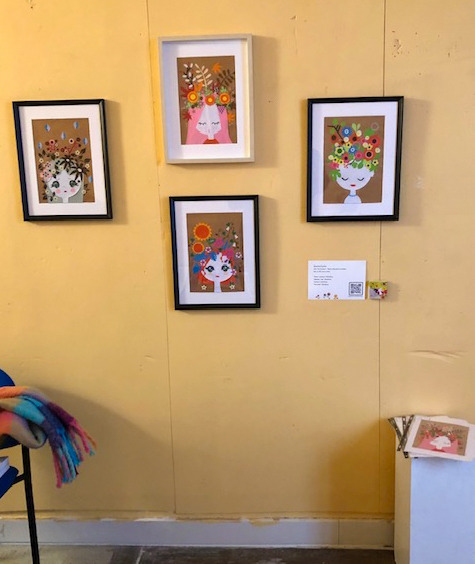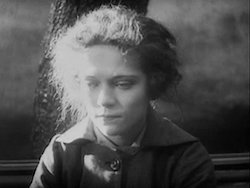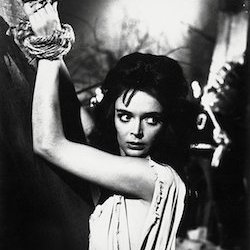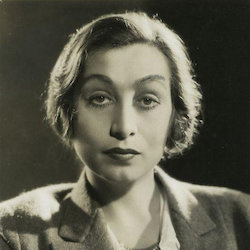#artistes de menilmontant
Explore tagged Tumblr posts
Text

Expo des petits formats - Artistes de Menilmontant (Paris 20)
0 notes
Photo

#church#notre dame de la croix#stairs#oldie#dog#dogs of tumblr#eating#homeless#cat#menilmontant#art#artists on tumblr#artist#photographers on tumblr#photography#photoshoot#photo#black and white#original photographers#original photography blog#street#street photography#city#citylife#cityscape#citystyle#cityshots#citystreets#contemporary#contemporary art
3 notes
·
View notes
Text
VISAGE... VOICE... VITAPHONE

In Dimitri Kirsanoff's Menilmontant a destitute waif, betrayed and abandoned by the man who seduced her, sits on a park bench with her newborn infant. Beside her is an old man eating a sandwich. This wordless exchange is one of the greatest moments ever committed to film. Nadia Sibirskaia’s face reveals all of life’s cruel mysteries as she gazes upon a crust of bread.
The persistence of hope is the dark angel that underlies despair, and here it taunts her mercilessly. A whole series of fluctuations of expression and movement in reaction to anguish, physical pain involving hesitation, dignity, ravenous hunger, survival, self-contempt, modesty, boundless gratitude. All articulated with absolute clarity without hitting notes (without touching the keys). Chaplin could have played either the old man on the bench (his mustache is a sensory device!) or Nadia. And it would have been masterful and deeply affecting, but Nadia went beyond virtuosity and beyond naturalism.
She made it actual. And it was more than just a face. Sunlight travels across buildings at every second of the day; and the seasons change the incidence of light, too. Nothing stands still. Even déjà vu doesn’t attempt an exact rendition with the feel of a perfect replay.
***

Another face equates with pain—though a far more luxurious and decadent kind of pain, a visage summoning leftover ancient Roman excess or Florentine backstreets, the contortions of Art Nouveau with its flowers, prismatic walls and perennial themes of ripeness/rottenness, sadomasochism. While various directors have helped mold her naturally unsettling screen presence into nightmare visions, it’s Barbara Steele's vulnerability I tend to remember.
She is open and sensitive even as she materializes in the viewer’s mind as a kabuki demon one moment and a radioactive waxwork the next, a kind of alchemical transformation, an appeal to what Keats called negative capability—one’s ability to appreciate something without wholly understanding it; in fact, one’s ability to appreciate an object for its mystery.
“When did I ever deserve this dark mirror?” Barbara Steele asks me. “Clever you – I feel you’ve just twisted and wrung out an old bible to dry that’s been left somewhere outside lost in timeless years of…” She pauses. “…of rain.”
She made her Italian screen debut as a revenant. And in so doing taught us all the eye is not a camera. It’s a projector.
Barbara Steele’s appearance in 1960’s Black Sunday is, even now, a shock of such febrile sexuality that it forces us to ask ourselves—why do we saddle her with diminishing monikers like “Scream Queen”? And, more fundamentally, why does her force of personality seem to trouble and vex every narrative she touches?
Of course, the answer is partly grounded in Steele’s unique physical equipment—and here I’ll risk repeating a clichéd word about those famous emerald eyes of hers: “Otherworldly.” As if sparked to life by silent-film magician Segundo de Chomón, the supreme master of hand-tinted illusionism. Peculiar even within the context of gothic tales on celluloid for the consumption of Mod audiences, flashing at us from well beyond their allotted time and place in history.
Barbara Steele is one of cinema’s true abominations—a light-repelling force that presents itself in an arrangement of shadows on the screen. No “luminary,”Steele is celluloid anti-matter; a slow burning black flame that devours every filament around it. Steele’s beauty is no accident of nature, even if she is, but in Black Sunday she gives a virtuoso performance by an artist in full command of her talent summoning and banishing it in equal measure in her dual role as mortal damsel in distress and undead predator released from her crypt. Filmmaking is the darkest and unholiest of arts (done right, that is), and for Mario Bava it becomes the invocation of beast and woman from the unconsecrated soil of nightmares. Steele remains the high priestess of the unlit and buried chambers of the imagination; the pure pleasure center of original sin and the murderous impulse buried just below the surface. She reminds us that existence itself is the highest form of betrayal and a continuing curse on us all.

Where Steele’s Italian films are concerned, we are watching silent movies of a sort. “The loss of voice for me has always been devastating…. It’s almost like some karmic debt…” Her sonic presence was eclipsed in a string of crudely, sadly dubbed horror vehicles, yes, including Black Sunday—no doubt aficionados of the great Mario Bava will object to my calling it a “vehicle.” But whenever Steele appears, the storyline falls away. Anachronism rules. Not to mention the director’s exquisite sets, all keyed and subordinated to his ingénue’s stark loveliness (understood in black and white, molded by Italian cameramen into disquieting and sudden plasticity). Like a hot-blooded funerary sculpture made of alabaster, raven hair piled high, Steele’s already imposing height summons schizoid power, satanic sorcery—she’s Eros and Thanatos dynamically balanced. I’ve screened the film many times; and the famous opening sequence invariably leaves my otherwise jaded film students looking traumatized. (Just as a young Martin Scorsese was shattered by it once upon a time.) Barbara Steele’s defiant witch, spewing a final curse upon her mortal judges, pierces to the bone.
While Italian movies robbed Steele of her voice, they liberated her from what it had meant in Britain. Leading ladies in Brit films tended to be well brought-up young things, unless they were lusty and working-class like Diana Dors. Even at Hammer, where sexuality was unleashed regularly via bouts of vampirism, the erotically active roles usually went to continental lovelies (Polish immigrant Ingrid Pitt got her work permit based on Hammer’s claim that no native-born actress could exude such desire and desirability). Steele turns up all-too briefly in Basil Dearden’s Sapphire (1959) as an art school girl, the only kind of role that might allow for both intelligence and a certain liberated attitude. And Steele really was exactly that type. Her appearance is so arresting, you want the movie to simply abandon its plot and follow her into some fresh storyline: it wouldn’t really matter what.
In Italy, Steele suddenly became class-less and nation-less, devoid of associations beyond those conjured by the chiseled cheekbones and enormous eyes (convincingly replaced with poached eggs by Bava for a special effects shot). Her inescapable exoticism didn’t make sense in her native land, but that bone structure could suggest Latin, Slavic, or anything else. Omninational, omnisexual, but definitely carnivorous.
Generally remote with his actors, who were nothing more than compositional elements to him, Bava’s capricious move of selecting his female lead from a magazine photo-spread looks almost prescient in hindsight. Was it luck? Or, perhaps her now legendary eyes suggested a bizarre and beautiful leitmotif… to be destroyed, resurrected, and played endlessly on a register of emotions—extreme emotions, that is, tabooed delights.
Steele shares an anecdote about her director’s temperament and working methods on Black Sunday… “Everything was so meticulously planned that Bava rarely asked me for multiple takes. There was no sense of urgency or drama, which was rare for an Italian director…” I’m suddenly detecting deep ambivalence as she vacillates between little jabs at Bava (“He was a Jesuit priest on the set, somewhere far away”) and gratitude. “There was a tremendous feeling of respect, whereas in my earliest roles at Rank I always felt shoved around, practically negated by the pressure of production.
“Bava did go absolutely berserk once,” she goes on. “John Richardson, this gorgeous, sinewy creature, for some reason couldn’t carry me across the room. And I was like eleven pounds in those days. We had to do it over and over, twenty times or something, and whenever John stumbled or dropped me, the whole crew would be in hysterics. We were all howling with laughter, except for Bava – he went simply wild! Eventually, some poor grip had to get down on all fours, and I rode on his back in a chair with John pretending to carry me.”
If Black Sunday is a summation of spiritual and physical dread, it’s because Steele is everyone in this dream-bauble, everyone and everywhere, an all-consuming autumnal atmosphere. Which, of course, provides Mario Bava with something truly rare—a face and mien as unsettling as horror films always claim to be and almost never are. The devastation she leaves behind, her anarchic displacement, which has nothing to do with conventional notions of performance or “good acting,” is hard to describe. And here Bava earns his label of genius through compositional meaning—amid the groundswells of fog, lifeless trees and gloomy dungeons, Steele is an absence impossibly concretized in penumbras and voids. She is a force of nature never to be repeated.
Nightmare Castle (1965) starts off in Lady Chatterley mode as Steele cheats on her mad scientist husband (“At this rate you’ll wipe out every frog in the entire county,” is an opening line less pithy but more arresting than “Rosebud”) with the horny handyman. She’s soon murdered on an electrified bed, hubby preserving her heart for unexplained reasons while using her blood to rejuvenate his mistress. Then he marries her insipid blonde half sister (Steele again in a blonde wig) and tries to drive her mad. So we now have Gaslight merged with Poe and every revenge-from-the-grave story ever.
The identical twin half-sisters (?) bifurcate further: blonde Barbara goes schizoid, possessed it seems by her departed semi-sibling. Dark Barbara comes back as a very corporeal revenant, hair occluding one profile, like Phil Oakey of the Human League. Tossing the locks aside, she reveals… the horror!
Almost indescribable in terms of plot, character or dialogue, the film looks stunning, as chiaroscuro as Steele’s coal-black hair and snow-white skin. Apparently the product of monkey-typewriter improvisation, the story serves as a kind of post-modern dream-jumble of every Gothic narrative ever. You might get a story like this if you showed all of Steele’s horrors to a pissed-up grade-schooler and then asked them to describe the film they just saw. As a result, the movie really takes what Dario Argento likes to call the “non-Cartesian” qualities of Italian horror to the next dank, stone-buttressed level.
When I first met Barbara Steele about ten years ago, we somehow found ourselves sitting in front of a Brancusi sculpture here in New York City—I remember a filmmaker acquaintance joking afterwards: “Steele beats bronze!” Indeed, at 66 she was still stunningly beautiful, flirtatious, frighteningly aware of the power of her stare.
She was a painter in her youth, so it’s not surprising that, even as I visualize her in a voluptuous, cinematic world of castles and blighted landscapes, her own self-image is perennially absorbed by art—in the sense of André Malraux’s Museum Without Walls. She asks me to show her my paintings and when I dodge the subject out of shyness she offers:
A friend of mine just had a show of his art in a little cinema here – very small paintings, about 8 inches by 6 – and then they projected them onto one of their screens and they looked fantastic! Size is everything! Unless you were born in the Renaissance… then you were surrounded by silence and stone walls, shadows and glimmers of gold, and faces that are like spells they look so informed.
Steele speaks of her “old, suspicious Celtic soul,” her bitterness at having “flitted through movies par hazard,” and a newfound desire to make audio books (what colossal revenge!). It’s poetic really, this doppelganger, a ghost-like screen persona following her around. Whenever I think of the effect her movies have had on me, the following words by Charles Lamb leap to mind.
Gorgons and Hydras and Chimaeras – dire stories of Celaeno and the Harpies – may reproduce themselves in the brain of superstition – but they were there before. They are transcripts, types – the archetypes are in us, and eternal. How else should the recital of that which we know in a waking sense to be false come to effect us at all? Is it that we naturally conceive terror from such objects, considered in their capacity of being able to inflict upon us bodily injury? O, least of all! These terrors are of older standing. They date beyond body – or without the body, they would have been the same… That the kind of fear here treated is purely spiritual – that it is strong in proportion as it is objectless on earth, that it predominates in the period of our sinless infancy – are difficulties the solution of which may afford some probable insight into our ante-mundane condition, and a peep at least into the shadowland of pre-existence.
Even the wooliest metaphysics can be hard to separate from actual violence. Case in point: the night of September 22, 1796. Charles Lamb had his own brush with horror, when the future poet and author of children’s stories found himself removing a bloody knife from his sister’s hand. A spasm of matricidal rage that would land her in a mad house—and tending to prove, once again, the need for genres of terror and trepidation. For a moment at least, Steele seems to agree, bowled over by the Lamb anecdote, literally screaming: “AND THAT NAME – LAMB – IT MAKES YOU THINK OF SUCH INNOCENT BRITISH LANDSCAPES!” She’s a fairly solitary and introspective person on the one hand, capable of intense and unexpected eruptions of joy on the other, which may be why Italians have always embraced her—a shared gloomy zest for life, fatalism and pasta. There’s something intensely porous about her (as porous as film itself), which helps clarify her otherwise inscrutable tension with that shadow-self up on the screen, the one she so busily downgrades.
***

The thirties bustled with wise-cracking, fast-talking dames, probably not for any proto-feminist reason, but simply because the writers had a surplus of sassy talk to dispense onto the screen, and audiences liked looking at legs, so why not combine the two? Amid all the petite peroxide pretties, a few acerbic character actresses were allowed room, perhaps to make the cuties bloom all the more radiantly against them. Whatever the aesthetic logic, we can be grateful for it, since it gave us Ruth Donnelly and Winnie Lightner and Jean Dixon and a few other unforgettable shrews and wiseacres, adept as stage mothers, streetwise best pals of the leading lady, etc.

Aline MacMahon sort of fits into this category, but also destroys any category she sees with her laser vision. In Gold Diggers of 1933, she’s a Fanny Bryce type comedy showgirl, and in Heat Lightning (1934) she’s an ex-moll running a garage. In between, she played world-weary secretaries and put-upon mothers, taking any role and stealing the movie along with it. Rather than resist classification, she goes on the offensive, smashing down stereotypes and insisting on her own peculiar individuality.
Big and rangy in the body and hands, she had a strange, sculpted beauty, and was as luminous as Dietrich. Maybe more so: cameramen hit Marlene with brighter lights to make her shine out, whereas Aline was typically in the lead’s shadow. Her complexion is like the glass of milk in Suspicion in which Hitchcock planted a light bulb. That white. A sheet of paper passing before her face would appear as a dark eclipsing rectangle.
The law of photogenics insists that actresses hired to play the non-glamorous roles must be staggeringly lovely, but off-kilter and unconventional enough to fool the audience into thinking they’re seeing failed beauty. Aline’s unlikely photofit of attractive features resulted in a caricature of elegance and earthiness in precisely the wrong proportions, which makes her fascinating and alluring to watch.
The eyes are seriously big, saucers hooded by the heaviest lids since Karloff’s monster, resulting in long slits which strive to echo the even wider mouth, a perfectly straight line seemingly intent on decapitation. Like a horizon with lips. The chin cleft below catches the viewer by surprise. Were chin clefts on women more common then, or did studios screen in favor of them? The cheekbones have a graceful, yet powerful curve, so the face as a whole combines the qualities of an ice-cream baby and a crystal skull. All wrong, and alright with me.
Aline’s humor about her ill-assorted collection of perfect features was often played on in dialogue, so it’s pleasing when a role like the one in Heat Lightning admits that, for all her unlikeliness, she was indeed beautiful. More than a pretty face, too: her way with a snappy rejoinder distinguished her even in an era of exceptional wit and quicksilver delivery. And her essence, which radiated out whatever the role, was that of a philosophical, warm, smart, funny, sad woman: the essence of the age.
By Daniel Riccuito and David Cairns
5 notes
·
View notes
Photo

Petit rappel : Dernier jour pour venir découvrir mon nouvel atelier et mes nouvelles œuvres. Je vous attends à partir de 14h et jusqu’à 20h :-) #peintre #painter #collage #peintrecontemporain #contemporarypainter #artiste #artist #art #artcontemporain #contemporaryart #jeremiebaldocchi #baldocchi #exposition #exhibition #expositionpeintures #exhibitionpaintings #menilmontant #artistesmenilmontant https://www.instagram.com/p/B2_X7_NIo2J/?igshid=tft8fwp7odjk
#peintre#painter#collage#peintrecontemporain#contemporarypainter#artiste#artist#art#artcontemporain#contemporaryart#jeremiebaldocchi#baldocchi#exposition#exhibition#expositionpeintures#exhibitionpaintings#menilmontant#artistesmenilmontant
1 note
·
View note
Photo

Demain c’est... … une nouvelle chance de devenir une meilleure version de soit… ✌🏽🫧 #belleville #paris #france #bellevillezoo #café #artderue #graffiti #artist #streetart #binks #banks #bronx #paname #blvl #menilmontant #maville #tiecs #hood #colors #manager #artiste #rap #rapfr #nft #mj #casper #ghost #nextup (à Belleville Paris 20) https://www.instagram.com/p/CgMUbqhrAcP/?igshid=NGJjMDIxMWI=
#belleville#paris#france#bellevillezoo#café#artderue#graffiti#artist#streetart#binks#banks#bronx#paname#blvl#menilmontant#maville#tiecs#hood#colors#manager#artiste#rap#rapfr#nft#mj#casper#ghost#nextup
0 notes
Photo

Les Artistes de Ménilmontant : 150 ans de la Commune. #menilmontant #lesartistesdeménilmontant #lacommunedeparis #lacommunedeparis1871 #150anscommunedeparis #150ansdelacommune #elisabethdmitrieff #andreleo #nathalieleme #lesamisdelacommune #instapic #photooftheday #parismaville #mairiedeparis (à Menilmontant 20ème) https://www.instagram.com/p/CM1jJaWlHmB/?igshid=b8ck9def9ii4
#menilmontant#lesartistesdeménilmontant#lacommunedeparis#lacommunedeparis1871#150anscommunedeparis#150ansdelacommune#elisabethdmitrieff#andreleo#nathalieleme#lesamisdelacommune#instapic#photooftheday#parismaville#mairiedeparis
0 notes
Photo

Artist ?, Rue de Menilmontant, Paris, 05/2017
8 notes
·
View notes
Photo

Rue des cascades Artist @manyoly #streeart #paris #women #pasteup #collage #20eme #belleville #menilmontant
0 notes
Photo

Journées Portes ouvertes de mon nouvel atelier Du jeudi 26 au dimanche 29 Septembre 2019 de 14h à 20h Vernissage le jeudi 26 Septembre à partir de 19h et jusqu'à 22h J'en profite pour présenter quelques œuvres d'un ami artiste Elias Tobares Programme : • Vente de dessins encadrés • Déstockage à petit prix d’anciennes œuvres • Mise en vente et Dédicace de mon livre • Vente de cartes imprimées Mon adresse : 4 villa de l'Ermitage - 75020 Paris Métro : Jourdain (ligne 11) ou Gambetta (ligne 3) Mon numéro au cas où : 06 88 54 59 53 Plus d'infos: www.jeremiebaldocchi.fr/peintre/?p=2602 #peintre #painter #collage #peintrecontemporain #contemporarypainter #artiste #artist #art #artcontemporain #contemporaryart #jeremiebaldocchi #baldocchi #exposition #exhibition #expositionpeintures #exhibitionpaintings #menilmontant #artistesmenilmontant https://www.instagram.com/p/B1Ttxb8iFCc/?igshid=3fzvxdzzqk3k
#peintre#painter#collage#peintrecontemporain#contemporarypainter#artiste#artist#art#artcontemporain#contemporaryart#jeremiebaldocchi#baldocchi#exposition#exhibition#expositionpeintures#exhibitionpaintings#menilmontant#artistesmenilmontant
1 note
·
View note
Photo

Merci à tous ceux qui sont venues découvrir mes nouvelles œuvres, pour les autres c'est encore ouvert aujourd'hui et demain de 14h à 20h :-) #peintre #painter #collage #peintrecontemporain #contemporarypainter #artiste #artist #art #artcontemporain #contemporaryart #jeremiebaldocchi #baldocchi #exposition #exhibition #expositionpeintures #exhibitionpaintings #menilmontant #artistesmenilmontant https://www.instagram.com/p/B28oUBCCTW1/?igshid=efl7kdn5vmsk
#peintre#painter#collage#peintrecontemporain#contemporarypainter#artiste#artist#art#artcontemporain#contemporaryart#jeremiebaldocchi#baldocchi#exposition#exhibition#expositionpeintures#exhibitionpaintings#menilmontant#artistesmenilmontant
0 notes
Photo

Rue des cascades Artist : @kamlaurene #streetart #menilmontant #pasteup #collage #paris20 #20eme
0 notes